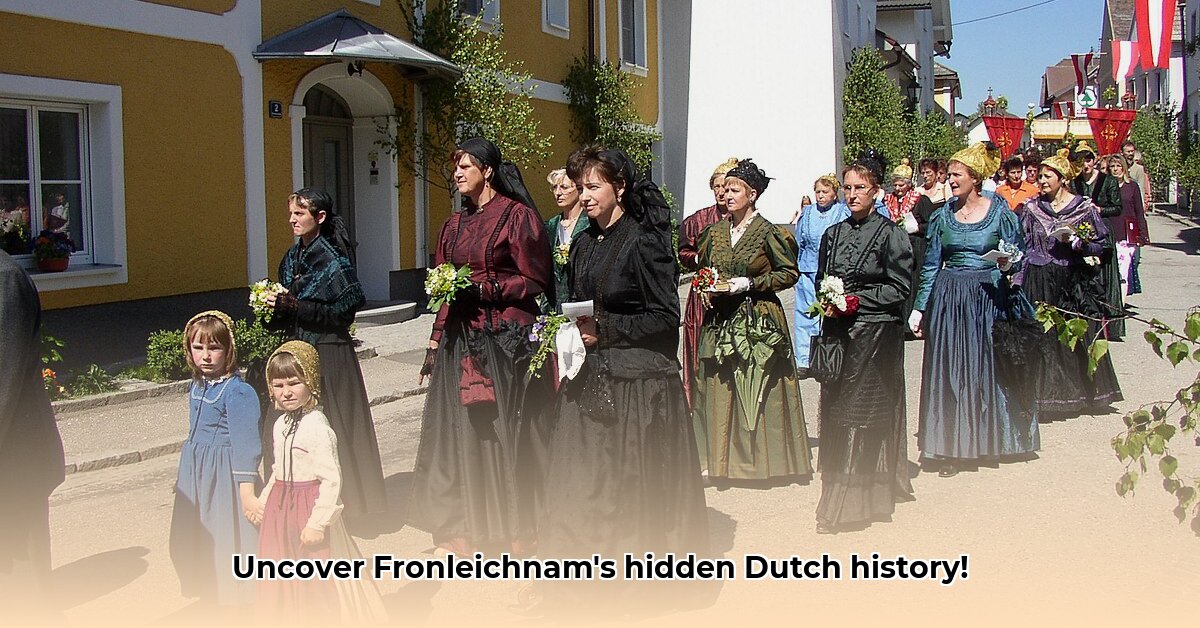
Fronleichnam, or Sacramentsdag in Dutch, is more than a religious holiday; it's a vibrant tapestry woven from centuries of Dutch faith and culture. Imagine a colourful procession snaking through a town square, hymns filling the air – that's the heart of Fronleichnam. This celebration of the real presence of Christ in the Eucharist (the consecrated bread and wine) holds deep meaning for many Dutch Catholics. The official date, the Thursday after Trinity Sunday, sometimes shifts to the following Sunday for broader accessibility, showcasing how global traditions adapt to local contexts.
A Story of Suppression and Resurgence
From 1848 to 1983, public Fronleichnam processions were sadly banned in the Netherlands. This suppression profoundly impacted the public expression of faith, silencing a significant element of Dutch community life. However, faith proved resilient. The revival of these processions after 1983 wasn't merely a restoration of an old tradition; it was a powerful statement of faith, a re-emergence in a changing societal landscape. It represents the enduring strength of the human spirit. This period of suppression and subsequent revival offers valuable insights into the relationship between religious practice and societal shifts in the Netherlands.
Modern Fronleichnam: A Living Tradition
Today's Fronleichnam celebrations retain core traditions. The procession, a moving symbol of faith, remains central. Prayers, hymns, and reverence for the Eucharist are integral elements. But what truly distinguishes Dutch Fronleichnam are the unique regional variations. Every parish adds personal touches and traditions, creating a rich diversity across the country.
How do people experience this today? Participation fluctuates geographically and annually, yet the festival retains immense significance for many devout communities. It's a time for quiet contemplation, communal prayer, and a reaffirmation of shared beliefs – a powerful force in our modern world. But how can we ensure its continued relevance? What are some of the challenges and opportunities facing the future of Fronleichnam in the Netherlands? These are questions worth considering.
The Future of Fronleichnam: Adapting to the Times
What does the future hold for Fronleichnam? Many believe continued adaptation is crucial for its survival. Engaging younger generations and exploring innovative expressions of faith will likely be key. Church leaders and community members share a vital role in keeping the celebration relevant and meaningful. There's a rich ongoing dialogue on best practices, with diverse communities experimenting with various approaches. This adaptive nature is crucial to the continued relevance of Fronleichnam in the present day.
A Collaborative Effort: Working Together to Preserve a Legacy
The preservation of Fronleichnam requires a collaborative effort, drawing on the strengths of various stakeholders. A successful strategy needs commitment from diverse groups to ensure the long term sustainability of this historic celebration. Below is a potential plan aimed at enhancing future celebrations:
| Stakeholder | Short-Term Goals (0-1 year) | Long-Term Goals (3-5 years) |
|---|---|---|
| The Catholic Church | Resource creation; increased promotion of the event; participation analysis. | Investment in youth; intergenerational bridge-building; theological significance emphasis. |
| Local Communities | Tradition preservation (storytelling, recording); inclusive event development. | Interfaith collaborations; community building; tourism initiatives. |
| Historians & Scholars | Full impact research on suppression and revival. | Detailed studies of contemporary Fronleichnam experience. |
| Tourism Organisations | Fronleichnam promotion as a unique heritage event. | Development of tourist trails; highlighting relevant historical sites. |
The story of Fronleichnam in the Netherlands is compelling – one of resilience, faith and adaptation. It's a living testament to the enduring power of belief in a dynamic world. Its future depends on collaboration and understanding within various communities.
Key Takeaways:
- Fronleichnam’s Dutch history showcases faith’s enduring power.
- The procession unites communities in a powerful display of shared belief.
- Declining participation requires innovative solutions.
- Revitalisation needs inclusivity, modernisation, and community engagement.
- Sustainable tourism can boost awareness and participation.